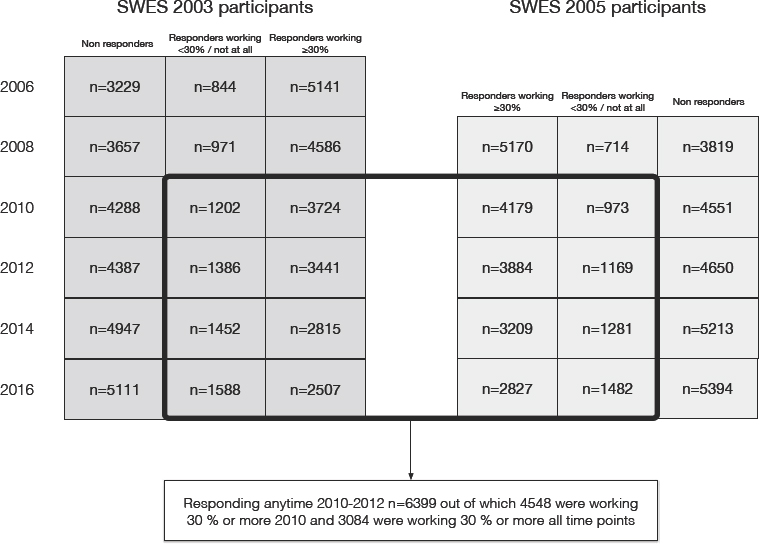Low-back pain remains a major public health concern generating large healthcare costs and productivity losses (1). Low-back pain is the leading cause of years lived with disability globally (2, 3). Over 60–70% of all individuals may experience problems with back pain at some point in their life (4). The work environment in which many people spend a large part of their lives, may influence whether an individual develops disabling musculoskeletal problems, including low-back pain (5). A great deal of research has recognized the importance of physical working conditions for the development of low-back pain (5). People with physically demanding work seem to develop more back problems than others, eg, those with manual labor including heavy lifts, with twisted or bent positions, kneeling or squatting or who are exposed to vibrations (5). A number of studies indicate that also psychosocial factors may be of relevance (5–7). Studies with a longitudinal design that take earlier symptoms into account indicate causal associations between, eg, high job demands and low job control, job strain (the combination of high job demands and low control), as well as low support at work and low-back pain (6, 7). However, the evidence for psychosocial factors is generally weaker, and it has been questioned whether these associations represent causal associations or are due to bias or confounding (7).
To rule out that unmeasured third variables explain the associations between psychosocial work factors and low-back pain, some scholars recommend cross-lagged analyses based on repeat measures (7). These types of analyses may also shed light on the causal direction of the associations, which remains uncertain (7). Cross-lagged analyses cannot, however, completely rule out the influence of individual differences (8). It is possible that genetic or earlier life experiences can confound these type of associations. Studies have shown that there is a relatively high heritability of disabling low-back pain (9) and that a weak constitution is a risk factor (10).
This study aimed to increase the knowledge about temporal relationship between job strain and low-back pain by examining whether there are lagged and bidirectional associations between the two. In addition, we aimed to rule out confounding from time-invariant characteristics.
Methods
Study population
The study population consisted of participants in the Swedish Longitudinal Occupational Survey of Health (SLOSH) study, a nationally representative longitudinal cohort survey focusing on work life participation, social situation, and health/wellbeing. SLOSH started in 2006 with a first follow-up of participants in the Swedish Work Environment Survey (SWES) 2003 (N=9214), containing individuals from the entire country stratified by county, citizenship, gainfully employed, and 16–64 years of age at the time of enrolment into SWES. About two years later, all eligible SWES participants were followed-up by means of postal self-completion questionnaires, one addressed to people in work, ie. those in gainful employment for ≥30% of full time, and one to people working less or who had left the labor force temporarily or permanently (11). All SWES participants from 2003 who were still alive, with a known address in Sweden, and who had not actively opted out, were asked to complete questionnaires again in 2008, 2010, 2012, 2014, and 2016. In 2008, all participants in SWES 2005 were added to the cohort (raising the number of cohort members to 18 917) to be followed up every second year, see figure 1. The present study is based on those SWES 2003 and 2005 participants who responded and were working in all four waves (2010–2016), in total 3084 individuals. Only data from 2010 and onwards was used since low-back pain was not assessed in the same way in earlier waves. Some characteristics of the 3084 included participants are presented in table 1. The Regional Research Ethics Board in Stockholm approved the study and informed consent was obtained from all participants.
Table 1
Characteristics of the study participants responding to the questionnaire for those in paid work 4 time points 2010–2016 (N=3084).
| 2010 a | 2012 | 2014 | 2016 | |||||
|---|---|---|---|---|---|---|---|---|
|
|
|
|
|
|||||
| N | % | N | % | N | % | N | % | |
| Sex | ||||||||
| Men | 1293 | 42 | ||||||
| Women | 1791 | 58 | ||||||
| Age | ||||||||
| Civil status | ||||||||
| Single | 607 | 20 | 612 | 20 | 615 | 20 | 632 | 21 |
| Married/cohabiting | 2424 | 80 | 2453 | 80 | 2443 | 80 | 2427 | 79 |
| Occupational status | ||||||||
| Low | 863 | 28 | 881 | 29 | 850 | 28 | 836 | 28 |
| Intermediate | 1395 | 46 | 1417 | 47 | 1460 | 48 | 1446 | 48 |
| High | 680 | 22 | 704 | 23 | 691 | 23 | 718 | 24 |
| Self-employed | 91 | 3 | 20 | 1 | 30 | 1 | 31 | 1 |
| Education | ||||||||
| Max 9 years of school | 187 | 6 | 187 | 6 | 187 | 6 | 186 | 6 |
| Upper secondary school | 1319 | 43 | 1311 | 43 | 1307 | 42 | 1299 | 42 |
| University | 1578 | 51 | 1586 | 51 | 1590 | 52 | 1599 | 52 |
| Physical activity | ||||||||
| Physically active | 2494 | 81 | 2524 | 83 | 2474 | 81 | 2441 | 80 |
| Physically inactive | 580 | 19 | 535 | 17 | 598 | 19 | 618 | 20 |
| Work schedules | ||||||||
| Daytime | 2341 | 77 | 2366 | 78 | 2402 | 79 | 2376 | 79 |
| Night work | 197 | 7 | 205 | 7 | 194 | 6 | 179 | 6 |
| Shift work excl. nights | 487 | 16 | 464 | 15 | 431 | 14 | 442 | 15 |
| Physically straining work | ||||||||
| No | 2587 | 84 | 2619 | 86 | 2667 | 87 | 2699 | 88 |
| Yes | 476 | 16 | 431 | 14 | 388 | 13 | 370 | 12 |
| Job strain | ||||||||
| No | 2529 | 83 | 2522 | 82 | 2520 | 82 | 2533 | 83 |
| Yes | 533 | 17 | 558 | 18 | 550 | 18 | 536 | 17 |
Exposure
Both job strain and low-back pain were measured repeatedly in the same way in the four waves. Job strain was measured by self-reports, using the Demand-Control Questionnaire (DCQ) (12), a widely used questionnaire operationalizing the demand-control-support model (13, 14). Four items (working fast, too much effort, enough time, and conflicting demands, Cronbach’s alpha 0.65–0.68) were used to create a score for demands at work and five items (learn new things, high level of skill, require initiative, deciding what to do at work, deciding how to do your work, Cronbach’s alpha 0.66–0.68) to create a score for control at work (15). Median split was used to divide the population according to high and low demands and control, respectively. People with a high demands and at the same time low control were considered exposed to job strain. The remainder formed the reference group.
Outcome
Low-back pain was measured by one item about the presence of back pain in the past three months in combination with an assessment of severity, in line with recommendations for prevalence studies (16). The severity criteria was based on ratings of how much the low-back problems affected the respondent’s life. Four groups were distinguished based on the response options: (i)no low-back pain, (ii) low-back pain, but does not affect my life at all, (iii) low-back pain that affects my life a little, and (iv) low-back pain that affects my life a lot. We also created a dichotomous indicator of any back pain as compared to no low back pain.
Covariates
A number of covariates assessed in the questionnaire in 2010 were included in the models, including sex, age, occupational status, education, civil status, obesity and physical strain at work, since these have been identified as potential confounders (5). Occupational status was coded according to the Swedish socioeconomic classification based on the occupation reported by the respondents, and divided into three categories: (i) low occupational status, including routine and manual occupations; (ii) intermediate occupational status, including non-manual intermediate occupations; and (iii) high occupational status, including higher managerial, administrative and professional occupations). Self-employed formed a separate category. Education was divided into three categories (primary school, upper secondary school, university). Civil status were divided into two categories (married or cohabiting versus single). Reported height and body weight was used to calculate body mass index (BMI) which was divided into obesity (BMI ≥30 kg/m2) versus non-obesity (BMI <30 kg/m2) according to the World Health Organization cut-off criteria. Also physical activity was assessed by one question: “How much do you exercise?”, from which two groups were formed: one active (exercises now and then or regularly) and one inactive group (exercises very little or never). We accounted for physical strain at work through a combination of two questions: whether work entailed heavy lifting or twisted positions at least ¼ of the time). Finally, we included information on current smoking (yes/no) and alcohol consumption (risky: ≥15 drinks/week for women, ≥22 drinks/week for men; or non-risky: <15 drinks/week for women or <22 drinks/week for men).
Data analysis
The associations between job strain and low-back pain, both any low-back pain and low-back pain severity were initially analyzed using cross-lagged models based on structural equation modeling (SEM). The cross-lagged paths estimated the association between job strain and subsequent low-back pain in successive waves and between low-back pain and subsequent job strain, after controlling for the stability of the variables over time and allowing for correlations between the parameters (17). We compared models in which cross-lagged regression coefficients were constrained to be equal across time and models where regression coefficients varied freely over time. As the former showed better fit to the data as compared to the latter (based on chi-square difference tests), henceforth the models were fitted with constraints on the structural paths over time. A robust weighted least squares estimator was used in the main models, which also allows for dichotomous and ordinal variables (18). However, to reduce possible bias introduced by missing information we alternatively used full-information maximum likelihood (FIML) estimation (19, 20). We first tested different models to better understand the temporal relationships between job strain and low-back pain. The first model, used as reference, only included auto regressions (temporal stability effects) between the main variables. The second model included auto regressions plus a path from job strain to low-back pain, while the third model included auto regressions and a path from low-back pain to job strain. Fourth and last, we fitted a model including auto regressions plus paths in both directions. Model fit was mainly assessed by the comparative fit index (CFI), and the root mean square error of approximation (RMSEA) (21). Values of RMSEA <0.05 and CFI ≈1 are assumed to be indicative of a well-fitting model. The adjusted models included sex, age, civil status, occupational status, education, and physical strain at work which have been indicated as confounders of the relationship between job stress and low-back pain (22). In sensitivity analyses, we also controlled for obesity, physical inactivity, smoking and risky alcohol consumption. A multigroup analysis, stratifying for sex, was also conducted to test for differences between men and women.
Additionally, we fitted analogous cross-lagged SEM models with fixed effects by means of dynamic panel models with fixed effects. Fixed effects methods include an alphai term treated as a set of fixed parameters representing all stable characteristics of a person. With this approach, each individual serves as his or her own control and major sources of confounding from time-invariant (fixed) factors (such as non-observed individual and environmental factors, eg, genetics, childhood conditions, and personality traits) are eliminated (23, 24). However, in contrast to standard fixed effects approaches, which use only variation within individuals to estimate the relationships between exposures and outcomes (assuming strict exogeneity), dynamic panel models with fixed effects allow for predetermined (sequentially or weakly exogenous) variables and the dependent variable to affect the predictor variable at a later point in time. Hence, it is possible to simultaneously estimate reciprocal relationships and loss of data due to differencing is avoided. Instead of eliminating all time stable measured and unmeasured factors, this approach uses a fixed-effects latent variable correlated with all time-varying independent variables to adjust for time-invariant characteristics of the individuals. To decrease complexity, separate dynamic panel models with fixed effects were used to estimate the cross-lagged coefficients, which also provides more flexibility in model specification and makes the estimation more robust to misspecification problems (Allison P, causal inference for panel data, available from: statisticalhorizons.com/resources) Reciprocal causation was accommodated by allowing the error term of the independent variable in each equation to correlate with future values of the time dependent predictors (25). As in the cross-lagged SEM models, we also here included contemporaneous effects, and both models with and without covariates were fitted.
All analyses were conducted using the lavaan 5.13 package in R.
Results
The characteristics of the sample are presented in table 1. There was a relatively high mean age of 48 years in 2010, and the majority was married or cohabiting and had a university education. The prevalence of low-back pain and other health conditions including neck/shoulder pain and migraine are presented in table 2. As much as 51% had complaints of low-back pain in 2010, however, only 6% reported low-back pain severe enough to affect their lives a lot. Among those who reported severe low-back pain, over half also reported neck/shoulder pain that affected their lives a lot, and around 25% also reported migraine that affected their lives a lot.
Table 2
Prevalence of low back pain and other types of health problems in 2010–2014.
Correlations between the main variables used in the analyses in 2010 are presented in table 3. The distribution of characteristics did not change much over the four waves among the total sample, as also indicated by the stability (autoregressive) coefficients in e Figures 1–2 in the appendix (www.sjweh.fi/index.php?page=data-repository). Additional analyses showed that a relatively high proportion had stable job strain status over time. All in all, 61% of those working all time points and with valid data on job strain (N=3034) did not experience job strain at any of the time points, 4% experienced job strain all time points, while the remaining 35% changed between no job strain and job strain over time. Among those with valid data on back pain from all time points (N=2958), 21% had no back pain over the period, while 28% experienced any back pain all time points and 49% changed between no back pain and any back pain over the study period.
Table 3
Correlation table based on data from 2010.
| SLOSH | Job strain | Low-back pain | Sex | Age | Civil status | Occupational status | Education | Obesity | Physical inactivity | Physically straining work |
|---|---|---|---|---|---|---|---|---|---|---|
| Job strain | 0.12 a | 0.06 a | -0.04 a | -0.04 a | -0.13 a | -0.06 a | 0.02 b | 0.02 b | 0.16 a | |
| Low-back pain | 0.03 b | 0.00 b | -0.01 b | -0.14 a | -0.11 a | 0.06 a | 0.05 a | 0.16 a | ||
| Sex | 0.01 b | -0.02 b | 0.00 b | 0.12 a | -0.06 a | -0.11 a | -0.09 a | |||
| Age | 0.01 b | -0.02 b | -0.08 a | 0.07 a | -0.04 a | -0.02 b | ||||
| Civil status | 0.06 a | 0.02 b | -0.04 a | -0.02 b | 0.01 b | |||||
| Occupational status | 0.53 a | -0.10 a | -0.02 b | -0.37 a | ||||||
| Education | -0.16 a | -0.10 a | -0.28 a | |||||||
| Obesity | 0.17 a | 0.06 a | ||||||||
| Physical inactivity | 0.04 a | |||||||||
| Physically straining work |
Figure 2
Cross-lagged path coefficients from the SEM model analyzing the bidirectional relationships between job strain and any low-back pain (dichotomous variable) while adjusting for sex, age, civil status, occupational status, education, and physical strain at work. The model was based on 2813 individuals (11 252 observations) with valid information on all variables. w=SLOSH wave, ε=error term, ***P<0.001
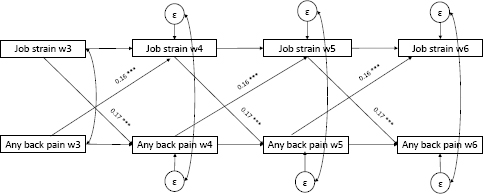
Cross-lagged SEM models
Initial chi-square difference tests showed that the reciprocal model had significantly better fit than models with only auto regressions, auto regression plus paths from job strain to back pain and auto regressions plus paths from low-back pain to job strain. The standardized regression coefficients from the reciprocal models are shown in figures 2–3, with adjustment for sex, age, civil status, occupational status, education, and physical strain at work. The analyses showed a relatively equal degree of association between job strain and any low back pain two years later [β=0.17, 95% confidence interval (95% CI) 0.13–0.22, P<0.001], and between any low-back pain and job strain (β=0.16, 95% CI 0.12–0.20, P<0.001), also shown in figure 2. The adjustment somewhat attenuated the estimates compared to the unadjusted models (β=0.24, 95% CI 0.20–0.28 and β=0.22, 95% CI 0.18–0.26, respectively). The results also showed significant relationships in both directions between job strain and the 4-category variable indicative of low-back pain severity (figure 3). The results further indicated that job strain was statistically significantly associated with an increase in low-back pain severity. The standardized β coefficients were 0.22, 95% CI 0.18–0.25 (P<0.001) in the unadjusted model and 0.18, 95% CI 0.14–0.21 (P<0.001) when adjusting for sex, age, civil status, occupational status, education, and physically straining work. An increase in low-back pain severity also predicted later job strain (standardized β 0.17, 95% CI 0.14–0.20, P<0.001 in the unadjusted model, and 0.14, 95% CI 0.11–0.17, P<0.001 when fully adjusted). The fit of the unadjusted models, including 2915 individuals, (RMSEA 0.13, CFI 0.71–0.80), as well as those including covariates (based on 2813 individuals) (RMSEA 0.12, CFI 0.72–0.83) was, however, quite poor.
Figure 3
Cross-lagged path coefficients from the SEM model analyzing the bidirectional relationships between job strain and low-back pain severity (ordinal variable) while including sex, age, civil status, occupational status, education, and physical strain at work. The model was based on 2813 individuals (11 252 observations) with valid information on all variables in the model. w=SLOSH wave, ε=error term, ***P<0.001
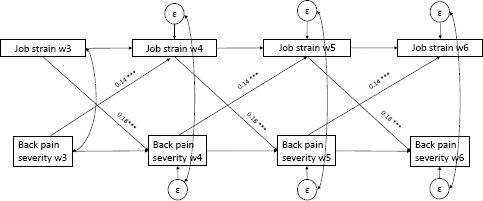
When comparing the model with and without constraints on the structural paths between men and women, the model with constraints fitted the data better according to the chi-square difference test, and RMSEA/CFI. This suggested that there were no clear differences in the estimates between men and women.
We also fitted models based on all 3084 individuals allowing for inclusion of missing information among the included variables and models including all those respondents working ≥30% in 2010 and had responded to any of the following waves (N=7044). Those analyses supported associations of similar magnitude in both directions.
Cross-lagged SEM models with fixed effects
The SEM models with fixed effects showed very good fit to the data according to both CFI and RMSEA. For back pain as a dichotomous variable, the path coefficient from job strain to later back pain was -0.06 (95% CI -0.14–0.02, P=0.70, RMSEA 0.05, CFI 0.98), and the path coefficient from any back pain to job strain was similar (-0.07, 95% CI -0.17–0.04, P=0.20 RMSEA 0.003, CFI 0.99). In the models analyzing back pain severity, the corresponding coefficients were -0.05, 95% CI -0.11–0.02 (P=0.9, RMSEA 0.05 CFI=0.99) and 0.00, 95% CI -0.11–0.11 (P=<0.001, RMSEA=0.06, CFI=0.98), respectively (figure 4a and 4b). All path- and correlation coefficients from the models on job strain and low back severity are further presented in the supplmentary e Figures 3a-b (www.sjweh.fi/index.php?page=data-repository). Inclusion of the same covariates as in the SEM models with fixed effects gave similar estimates, but inclusion of the covariates did not improve the fit of the models. The results were similar when allowing for inclusion of missing values in the analyses (on all 3084 individuals) through full information maximum likelihood estimation with calculations of robust standard errors. Analyses based on the sample responding in any of the waves (N=7044) also showed similar results.
Figure 4a
Cross-lagged path coefficient from the dynamic panel models with fixed effects analyzing the relationships between job strain and low back pain severity (ordinal variable). The model was based on 2915 individuals (11660 observations) with valid information on all variables in the model. w= SLOSH wave, ɛ=error term, α=latent variable to control for all time-invariant confounders, either observed or unobserved.
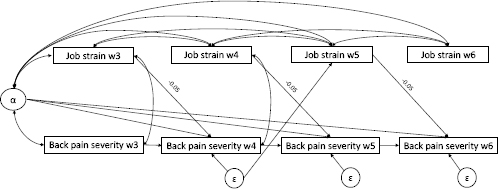
Figure 4b
Cross-lagged path coefficient from the dynamic panel model with fixed effects analyzing the relationships between low-back pain severity (ordinal variable) and job strain. The model was based on 1925 individuals (7700 observations) with valid information on all variables in the model. w=SLOSH wave,ε=error term, α=latent variable to control for all time-invariant confounders, either observed or unobserved, ***P<0.001
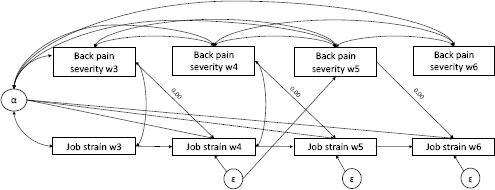
Discussion
In this panel study on a sample of the Swedish workforce, we found that bidirectional associations between job strain and low-back pain over a two year time lag disappeared when accounting for all time-invariant individuals characteristics. This indicates that the initial associations may be due to residual confounding from unmeasured characteristics such as genetics, childhood conditions, and stable personality traits.
To our knowledge this is one of the first studies to examine reciprocal relationships between job stressors and back pain (7). A study by Christensen & Knardal (26) also used data from three waves with a 2-year time lag and found a relationship between stable high quantitative demands and both new and persistent/recurrent back pain. They did not examine the relationship between back pain and work factors but acknowledged that there are likely reciprocal relationships. Our initial observations supported this notion. These findings were also similar for men and women, despite that women usually report more musculoskeletal pain (5).
However, there is a possibility that unmeasured background variables may be confounders of work stressors and strain relationships. In this study, we therefore examined bidirectional relationships at the same time as partialling out all time-invariant individual characteristics. The lack of an association between job strain and low-back pain in the analyses controlling for time-invariant characteristics may indicate that the associations were confounded by unmeasured time-invariant variables such as biological or psychological attributes that could be linked to circumstances earlier in life. A study using a similar approach as ours likewise indicated that the majority of associations between job stressors and mental health were contemporaneous. Only job demands appeared to have an effect on mental health one year later (27). This may also suggest that a shorter time lag would needed to capture the effects of job stressors like job strain even while ruling out major sources of confounding. A number of plausible pathways by which job stress may give rise to back pain have been suggested, eg, enhanced pain perception and increased muscle activity and muscle tension, but more knowledge is needed on mechanisms and the relevant time frame to capture potential effects (28).
This study had a number of additional strengths. By accounting for correlations between job strain and back pain and reciprocal paths the risk of reverse causality is limited in the main analyses. In the SEM models without fixed effects, we also controlled for a number of potential confounders at the first measurement occasion. Both demographic characteristics and biomechanical factors may be of importance to consider and our measure on physical work load was based on multiple items which is preferable to a single item measure (22). A robust version of the diagonally weighted least squares estimation was used which is the recommended approach for obtaining SEM estimates when using categorical data (29). The parameter estimates were also similar for the majority of models when robust standard errors were calculated in conjunction with full information maximum likelihood, an approach that seem to work well for non-normal data (30).
A limitation is that our main analyses is restricted to individuals who responded and were in paid work repeatedly. These people may be selected with regard to working conditions and health/wellbeing. Previous work show that SLOSH participants and especially those who have responded several times are to a higher extent women, older, married/registered partners, and highly educated. Dropout from the study may limit the generalizability of the study to more resilient individuals and have led to an underestimation of the relationship between job strain and low-back pain.
Another limitation of our analyses is that potential time-varying confounding by other factors are not dealt with. It is possible that time-varying factors such as health behaviors and other health problems influence back pain and job strain. However, if health behaviors and other health problems are mediators rather than confounders, adjustment for them would give misleading estimates of total effects.
In this study, job strain was used as a proxy for job stress, but the estimates presented in this study are potentially underestimated by misclassification of exposure. Although the definition of job strain is the most commonly used definition in previous research it should be acknowledged that using median splits is a relatively crude way of operationalizing strain.
A misclassification of the outcome cannot be ruled out, which if non-differential could have contributed to a dilution of the estimates. There is no standard definition of low-back problems. Several expert groups on musculoskeletal problems have, however, recommended that low-back problems should be assessed by a measure that couples pain with a measure of functioning on, eg, work ability or life quality (16, 31), which was done in the present study. Even if we assessed low-back over the past three months, we do not know if low-back pain symptoms had persisted for a 3-month period to be regarded as chronic disabling pain with significant impact on people’s lives and society (32). There is, however, research that supports the validity of retrospective reports of pain status for a 3-month recall period (33).
Finally, our analyses do not clarify the role of job strain as a risk factor or prognostic factor. More research seems warranted also on the role of work stress for first incidence of low-back pain and for progression from acute to chronic pain.
Despite these limitations, the results of this study suggested that lagged relationships between job strain and low-back pain across 2 years may be due to residual confounding by time invariant individual and environmental characteristics. A failure to take into account unobserved time stable characteristics may thus overestimate relationships between psychosocial working conditions and low-back pain. However, it should be acknowledged that the results do not preclude short-term relationships between job strain and low-back pain. To determine if there are bidirectional associations between job strain and back pain future work is needed with more frequent repeat measurements, which may better represent the time lag for cause and effect and that account for time-invariant individual factors.


